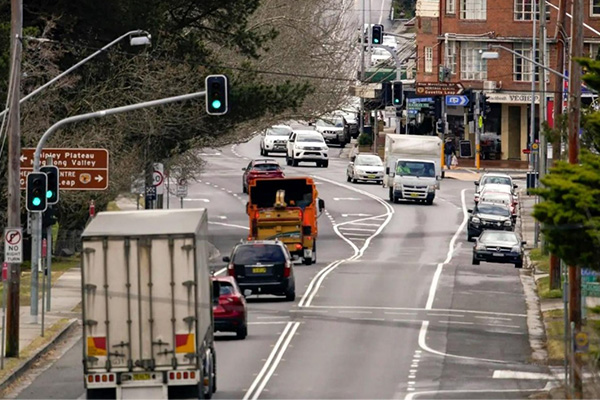…not just a highway or a car park
People flock to the Blue Mountains because of their World Heritage-listed natural beauty. There are some great trails in the National Park for walks and mountain bike rides. Yet, there’s a jarring dissonance when it comes to active transport. The natural beauty of Mountains villages and their old-world charm are let down by lack of safe places to walk and cycle, both within and between the towns.
This is because the road infrastructure has been designed for cars alone.
Members of Ride Blue Mountains at the mouth of the Glenbrook Tunnel (Image: Ride Blue Mountains)
Blue Mountains communities need better infrastructure to walk and ride
It’s incredibly hard for locals to get anywhere on foot or by bike in the built environment.
Furthermore, this will get worse. Not only that, visitor and through traffic is expected to grow by more than 20% over the next 12 years. Consequently, this will place more pressure on existing congestion choke points, particularly on the Great Western Highway. As a result, this could have negative social and economic impacts. Especially among the elderly who crave activity and connection. And kids who get driven to school because the roads are unsafe.
Any given day in the built environment at Blackheath (Image: Sydney Morning Herald)
The supremacy of trucks and cars also discourages private investment in urban revitalisation. As pollution and congestion edge pedestrians from town centres and public places. As a result, economic uplift opportunities may be lost.
What’s needed is a network of attractive interconnecting cycleways and shared user paths enabling residents to access important destinations. But also cater for visitors. Quality cycleways and pedestrian networks also encourage people to catch the train. Further reducing pressure on the roads and car parks.
Blue Mountains town centres would be greatly enhanced with decent places to walk and ride. Mountains communities want to walk and cycle more and drive less. After all, many residents move here seeking a relaxed, healthy outdoors lifestyle, not more urban traffic jams!
A leaked note from your local politician. Weighing up all the pros and cons of adding bike infrastructure and deciding it just cannot be done... (Image credit: Tom Flood)
But the pace of delivery has been glacial
Bicycle NSW and BUG Ride Blue Mountains are calling for greater investment in safe places to walk and ride. So, to encourage more active transport, advocates recommend quality shared paths connecting villages, shops, schools and pools. Ride Blue Mountains also wants more pedestrian and cycling bridges linking communities either side of the highway and rail corridor.
The NSW Government and the new Transport Minister have promised to work with the community to deliver active transport infrastructure in the Blue Mountains.
Bicycle NSW and Ride Blue Mountains welcome this commitment after decades of virtually zero investment.
Incredible biking and walking opportunities abound in the Blue Mountains (Image: Ride Blue Mountains)
This is what we’re asking from the NSW Government to make the Blue Mountains a place for people. And not just cars:
- Delivery of a high-quality upper mountains cycleway between Katoomba and Little Hartley. Notwithstanding any motorway tunnelling - above-ground active transport connections must be built whether or not the highway upgrades go ahead.
- Funding for active transport connections between town centres, shops, schools, and pools. This includes bridges between Buttenshaw Park and Macquarie Road, Springwood, and Sinclair Ave and Scotts Ave, Wentworth Falls/Leura.
- Upgrades to the Lapstone Hill pedestrian path are necessary. They will ensure the safe passage of cyclists and pedestrians between the River Walk and Viaduct Bridge and the Glenbrook Tunnel.
- Development of quality off-road mountain bike trails for recreational use by residents. And the promotion of bicycle tourism which is a major regional drawcard.
A commitment to these projects will be transformative.
Compared to motorway expansion, funding for active transport is a drop in the ocean
But whilst motorways are a dead-weight economic loss, active transport infrastructure is proven to deliver a minimum 5:1 Return on Investment (ROI). The $14million Westinvest funding from the WestConnex sale is a start. But it won’t build a mountains-wide network. Because, to mitigate increased traffic congestion on the Great Western Highway and balance community needs, more investment in active transport is needed.
Investing in active transport infrastructure will have broader economic benefits
Active Transport delivers massive health and wellbeing outcomes with proven economic benefits. This will not only boost visitor numbers and local businesses. It will also increase regional resilience to economic, climate and pandemic shocks impacting global tourism.
There are plenty of awesome plans and projects that have been designed and costed, such as the transformation of the Glenbrook Tunnel with a shared user path. Once completed, the tunnel will link Glenbrook and Lapstone villages with Leonay and Penrith's Great River Walk
(Source: Open Glenbrook Tunnel)
How can you advocate for NSW Government to invest in active transport in the Blue Mountains?
- Write to Trish Doyle MP and ask for her to action points 1-4 (above). Just copy and paste or, better still, write your own email
- Become a Bicycle NSW Member now
- Join Ride Blue Mountains or your local BUG and get active
- Sign up to the Better Streets coalition and campaign for better places to walk and ride






